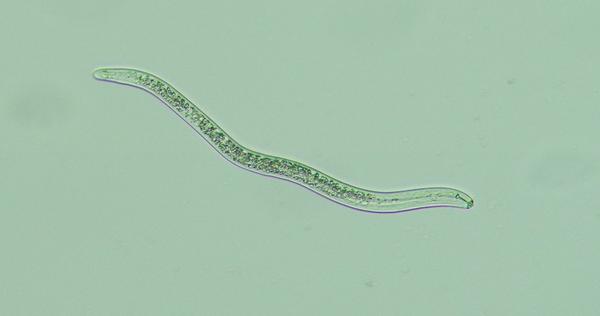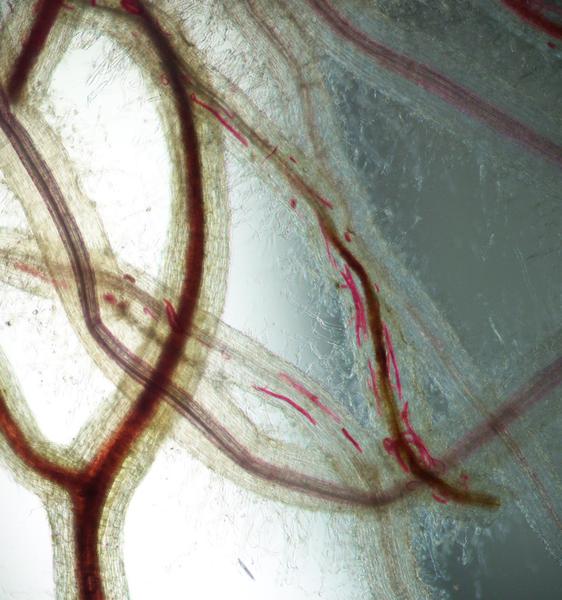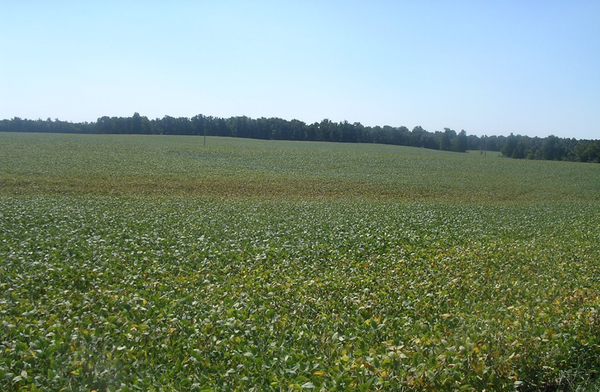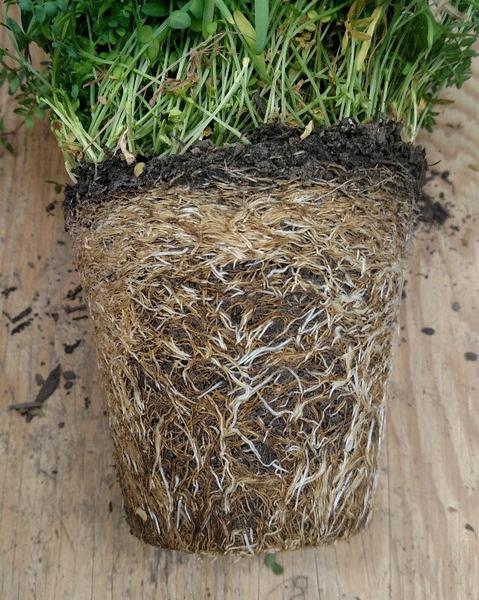Pathogen
Lesion nematodes belonging to the genus Pratylenchus are plant-parasitic roundworms that may cause economic damage in soybean production systems. These nematodes are known for their broad host-range of over 400 crop plant species worldwide (Table 1). The most common species found in corn in North Carolina include P. brachyurus, P. penetrans, P. scribneri and P. zeae (Figure 1). Lesion nematodes primarily feed within the plant roots and may predispose the roots to further infection by secondary microbes (Figure 2).
Lesion nematodes feed by lysing, or breaking open, cells of the roots which forms cavities. This allows them to migrate intracellularly (through the cells that compose the root) to continue feeding on healthy tissue. Necrotic lesions can be observed on the root as a result of the damage caused by feeding and movement. The feeding damage caused by nematodes can become an infection point for other pathogenic soil microbes.
Signs and Symptoms
Detecting lesion nematodes on soybean may be difficult as the symptoms observed above ground often mimic nutrient and drought stress. When nematode population levels are low, above ground symptoms may not be present; however, when large lesion nematode populations are present the plants may appear stunted, suffer from nutrient and water deficiencies, and eventually dieback (Figure 3).
Plant roots must be carefully dug and removed from the ground to observe the damage caused by lesion nematodes. Characteristic root symptoms of a lesion nematode infestation are dark, reddish-brown and black lesions along the roots, which often appear in discrete spots. As the season progresses and nematode feeding continues, lesions can coalesce to become necrotic areas of tissue that may eventually girdle the roots (Figure 4). A hand lens or magnifying glass can help to look for any black lesions or root damage.
Diagnosis
If a crop is suspected to be suffering from lesion nematodes, plants may be carefully dug from the soil and inspected for lesion nematode damage. A visual diagnosis includes checking the plant roots for black necrotic lesions, but does not indicate the level of nematode pressure in a given field. Diagnosis can be confirmed through assessment of soil or root samples for the presence of the nematode by a diagnostic laboratory or nematode assay laboratory. Soil samples for nematode assay services may be submitted to the North Carolina Department of Agriculture & Consumer Services, Agronomic Services (NCDA&CS), Nematode Assay Laboratory, 4300 Reedy Creek Road, Raleigh, NC 27607.
In order to determine nematode pressure, soil samples should be taken from several areas in the affected field. Using a soil probe, collect 20 to 30 soil cores across a 5 acre block, at a depth of 6 to 8 inches from each area using a grid-like pattern. Combine soil cores in a clean plastic bucket and remove a smaller portion of soil from this larger sample to submit to the Nematode Assay Laboratory. More detailed sampling instructions can be found at the NCDA&CS Nematode Assay Laboratory sampling guidelines.
Disease Cycle
Lesion nematodes are obligate biotrophs and require living plant roots to feed and reproduce. Lesion nematodes are migratory endoparasites, meaning they continue to move through roots even at the adult stage and retain a worm-like appearance throughout their life cycle. They can move through the soil, but mainly move and feed within plant roots. Their life cycle consists of six life stages: egg, four juvenile states and the adult stage. The life cycle typically takes 4 to 8 weeks to complete, but the generation time may be influenced by soil moisture, soil temperature, and host crop suitability. Female nematodes lay eggs one at a time in plant roots or soil, which develop into second-stage juveniles before hatching from the egg. The second-stage juvenile nematodes can penetrate plant roots to feed on the root cells and continue developing into adults. Adult lesion nematodes may exit and re-enter the roots. Under favorable environmental conditions (presence of a suitable host crop, sufficient soil moisture, and favorable temperatures) lesion nematode populations can increase to over 1,000 nematodes per gram of root. Lesion nematodes can overwinter in infested root tissue, weed hosts, or in the soil at any life stage.
Management
Managing lesion nematodes can be difficult due to their broad host range and lack of resistant soybean varieties. Routine nematode sampling is important to understand if a field has lesion nematode and monitor population counts. Knowledge of specific Pratylenchus species present in the field is helpful for determining if there is a non-host crop that can be integrated in the crop rotation (Table 1). Many species of lesion nematode can also infect, reproduce, and survive on common weeds. Therefore, good weed management will eliminate a potential food source for these nematodes. The two most effective management tactics for lesion nematode are sanitation and the application of chemical nematicides.
One effective way to manage lesion nematodes is to stop their introduction into the field, as they can be extremely difficult to get rid of once the infection occurs. Proper sanitation of all equipment shared between fields is an effective way of reducing the spread of lesion nematode between multiple fields. Sanitize by washing with a solution of 10% household bleach, removing any stuck soil, then rinsing with clean water and air drying before moving to unaffected fields or areas.
Another effective management tactic to reduce lesion nematode populations within the field is the use of nematicides. Pre-plant soil fumigation or as non-fumigant nematicides can reduce lesion nematode population levels to below economic thresholds. Fumigants such as 1,3-dichloropropene and metam sodium, as well as non-fumigant nematicides such as fluopyram, are available for use. Several seed treatments are also available for control of lesion and other nematode species in soybean, but should not be the only management strategy in high nematode pressure fields.
| Pratylenchus species | Host crops | Non-host crops |
|---|---|---|
| P. brachyurus | common bean, corn, cotton, cucurbit crops, okra, peach, peanut, soybeans, sweetpotato, tobacco, tomato, triticale cover crops | cabbage, lettuce, onion |
| P. penetrans | alfalfa, Bermuda grass, boxwood, corn, cotton, peach, red clover cover crop, rye, soybean, sweetpotato, tobacco, tomato, white potato | perennial ryegrass, Sudan grass |
| P. scribneri | cole crops, common bean, corn, cotton, onion, peach, soybean, tobacco, tomato, wheat | alfalfa |
| P. zeae | cole crops, corn, oats, okra, peach, sorghum, soybean, sugarcane, tall fescue, tobacco, wheat | peanut, tomato |
Additional Resources
- The NCDA&CS Nematode Assay Lab provides soil detection and diagnostics
- The NC State University Plant Disease and Insect Clinic provides diagnostic and control recommendations.
- The NC State Extension Plant Pathology portal provides information on disease management in corn and other crops
- The North Carolina Agricultural Chemicals Manual provides an up-to-date list of chemicals available for control of nematodes and other diseases and pests
- American Phytopathological Society resource for Lesion Nematode Disease has detailed information about lesion nematode
Acknowledgements
This factsheet was prepared by the NC State University Plant Nematology Lab in 2020, reviewed and updated in 2025.
Publication date: Sept. 8, 2020
N.C. Cooperative Extension prohibits discrimination and harassment regardless of age, color, disability, family and marital status, gender identity, national origin, political beliefs, race, religion, sex (including pregnancy), sexual orientation and veteran status.
Recommendations for the use of agricultural chemicals are included in this publication as a convenience to the reader. The use of brand names and any mention or listing of commercial products or services in this publication does not imply endorsement by NC State University or N.C. A&T State University nor discrimination against similar products or services not mentioned. Individuals who use agricultural chemicals are responsible for ensuring that the intended use complies with current regulations and conforms to the product label. Be sure to obtain current information about usage regulations and examine a current product label before applying any chemical. For assistance, contact your local N.C. Cooperative Extension county center.
N.C. Cooperative Extension prohibits discrimination and harassment regardless of age, color, disability, family and marital status, gender identity, national origin, political beliefs, race, religion, sex (including pregnancy), sexual orientation and veteran status.




